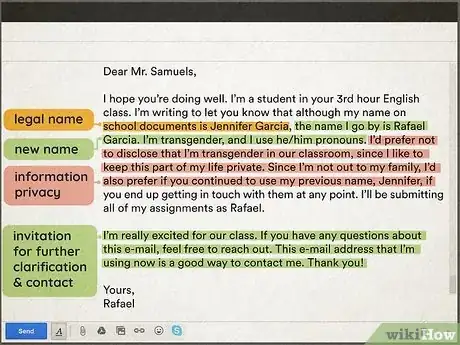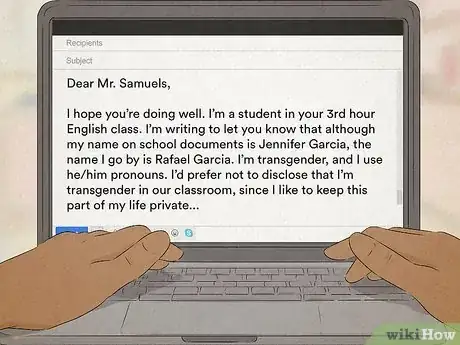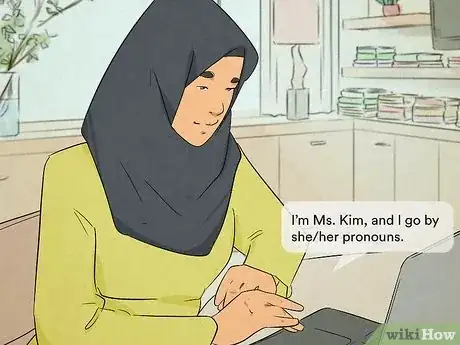This article was co-authored by wikiHow staff writer, Nihal Shetty. Nihal Shetty is a Writer and Editing Fellow at wikiHow who splits his time between Michigan and Mexico City. Before his role at wikiHow, he was an instructor of Russian literature at the University of California, Berkeley. Nihal received a BA in Comparative Literature from Columbia University and an MA in Russian at Berkeley.
This article has been viewed 3,998 times.
Learn more...
So, you’ve recently changed your name and pronouns (congrats!), or maybe you just need to let a new professor know that you don’t go by the name used on your school documents. Although you never have any obligation to come out to anybody, letting your teachers or professors know your correct pronouns and name (if it’s different from the name on your documents) can allow you to feel more comfortable in the classroom. We’ve put together a comprehensive guide on how to e-mail teachers about pronouns. Plus, if you’re an educator, we have advice on how to ask students for their pronouns, so read on!
Steps
Sample E-mails
-
1Dear Professor Shah,I hope you’ve had a good week. I’m a student in your chemistry lab section on Tuesdays and Thursdays at 3 in the afternoon. I’ve really enjoyed learning chemistry with you these past few weeks, and I wanted to send you this e-mail with some information. I’ve recently come out as nonbinary, and now go by the name Rowan, instead of my previous name, Jane. My last name, Wu, remains the same, although I use they/them pronouns. I’m open about my identity, and I’m okay if other people in the lab are aware of this.If you have any questions at all, please feel free to reach out via e-mail. I’m grateful for all your mentorship this term.Thank you, Rowan
-
2Dear Mr. Samuels,I hope you’re doing well. I’m a student in your 3rd hour English class. I’m writing to let you know that although my name on school documents is Jennifer Garcia, the name I go by is Rafael Garcia. I’m transgender, and I use he/him pronouns. I’d prefer not to disclose that I’m transgender in our classroom, since I like to keep this part of my life private. Since I’m not out to my family, I’d also prefer if you continued to use my previous name, Jennifer, if you end up getting in touch with them at any point. I’ll be submitting all of my assignments as Rafael. I’m really excited for our class. If you have any questions about this e-mail, feel free to reach out. This e-mail address that I’m using now is a good way to contact me. Thank you!Yours, Rafael
How to Ask Students for Their Pronouns (for Educators)
-
1Introduce your own pronouns first. At the start of a new term, introduce yourself by saying something like, “I’m Ms. Kim, and I go by she/her pronouns.” By sharing your pronouns, you’re signaling to your students that you’re someone they can feel comfortable with if their gender identity doesn’t match with their gender assigned at birth. It’s also an indication that you won’t be assuming pronouns.[3]
- If you’re already several weeks into a term, it’s not too late to introduce your pronouns. You can say something like, “I realize I never said this earlier, but my pronouns are he/him.”
- You can also write your pronouns down on the board or in an e-mail signature to your students.
-
2Invite your students to reach out to you with their pronouns. Either through e-mail or in person, tell your class something like, “If you have any questions about our course, please reach out to me. Also, if you’d like to inform me of a name that’s different from the one you’re registered under or your pronouns, feel free to send me a message.”[4]
- This approach can work better than asking everyone to introduce themselves with their pronouns at the start of class. Some students might not feel comfortable doing so in front of their peers.
- You can also send a survey to your students at the beginning of a term or mid-way through. Have them respond to a prompt like, “Please write your preferred name and correct pronouns here, if you feel comfortable doing so.”
-
3Respect your students’ confidentiality. Some students might not be out to their friends or family, so asking them for permission before sharing this information is important. Thank your student for sharing, then ask them in what contexts they’re comfortable with you using their new name and pronouns.[5]
- If a student indicates to you that they’re trans or otherwise gender non-conforming, tell them something like, “Thanks for sharing this with me. Just for clarity, are you comfortable with me using your preferred name and correct pronouns with other students or people outside of our class?”
Community Q&A
-
QuestionI am a trans guy. I'm nervous to tell my boss that I use he/they. Should I?
 NicoTop AnswererYes. If those pronouns will make you more comfortable at work, you should tell them.
NicoTop AnswererYes. If those pronouns will make you more comfortable at work, you should tell them.
References
- ↑ https://gsc.umn.edu/transgender-identities/coming-out-resources
- ↑ https://gsc.umn.edu/transgender-identities/coming-out-resources
- ↑ https://www.hdesd.org/6-quick-teacher-tips-for-using-gender-pronouns-creating-inclusive-welcoming-classrooms-for-all-students/
- ↑ https://www.insidehighered.com/views/2018/09/19/why-asking-students-their-preferred-pronoun-not-good-idea-opinion
- ↑ https://www.hdesd.org/6-quick-teacher-tips-for-using-gender-pronouns-creating-inclusive-welcoming-classrooms-for-all-students/
- ↑ https://www.insidehighered.com/views/2018/09/19/why-asking-students-their-preferred-pronoun-not-good-idea-opinion
- ↑ https://www.schoolcounselor.org/Standards-Positions/Position-Statements/ASCA-Position-Statements/The-School-Counselor-and-Transgender-Gender-noncon#











-Step-16.webp)



-Step-26.webp)
-Step-16.webp)

















































